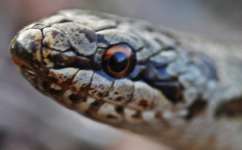Young smooth snakes rely on reptiles

A new way of using DNA analysis to find out what reptiles have been eating has revealed that the UK's rarest snake species may be under pressure because it needs very different kinds of food at different times in its life.
A paper in Molecular Ecology shows that young smooth snakes depend on reptiles such as small slow worms and other lizards until they get big enough to tackle mice, voles and other mammalian quarry.
By analysing the snakes' faeces for traces of prey genetic material, scientists from Cardiff University found that 85 per cent of smooth snakes had eaten reptiles lately, and only 28 per cent mammals; none of that second group were juveniles, and the likelihood of having eaten mammals grew with age and experience.
The results may explain why smooth snakes are confined to a few relatively small areas in southwestern England within the UK – they may need abundant reptiles to make it to adulthood, and only a few British habitats offer this.
'It's been claimed that smooth snakes are restricted to heathland, and that the loss of this habitat is what is affecting their numbers,' says Dr David Brown, who did the research while working on his PhD at Cardiff. 'But on the continent you find them in all kinds of habitats, so that theory doesn't stack up.'
The findings may also cast doubt on previous ideas about this rare and little-known snake's ecological niche. Studies elsewhere have suggested that it's an out-and-out reptile specialist, but this research implies this may not be true – or at least not in the UK where we have relatively few reptiles. Instead, smooth snakes seem to eat a lot of reptiles early on, but eventually broaden their diets by starting to eat mammals and other big prey too.
Brown says it may be that adult UK smooth snakes are resorting to mammals because they can't get enough lizards – or, conversely, it could mean smooth snakes in mainland Europe only seem to specialise on reptiles because this happens to be the commonest kind of prey in their areas, and not through any intrinsic preference. To know for sure we'd need more studies looking at the diets of European smooth snakes and how they change over time.
Molecular analysis of faeces is often used on other animal groups to find out what they've been eating, but this is the first time it's been applied to reptiles. The researchers weren't sure it would work – snakes digest their prey very thoroughly, sometimes even dissolving bones and all, so it wasn't a certainty that any DNA would survive long enough to be excreted. Now that the technique has been shown to give an accurate idea of reptile diets, it clears the way for a much better understanding of the ecology of many members of the family.
'We've proved the concept, and we hope these molecular techniques can now be used all over the world to help conservation by monitoring snake diets accurately and non-invasively,' Brown says. 'It's far easier to identify a particular species from its DNA than from tiny bits of fur or bones in its faeces.'
To do the research, he regularly visited two areas in southwest England that are protected by the Herpetological Conservation Trust – Ringwood in Hampshire and Creech in Somerset. He caught as many snakes as possible, and after determining their sex and approximate age, gently massaged them until they defecated. He then tested the samples for the presence of several possible prey animals, from voles and shrews to slow worms, frogs and slugs.
The researchers also examined the prey DNA of grass snakes in the same area. The results showed a few more reptiles than expected, but were broadly in line with the consensus on these snakes' diet, which is dominated by amphibians.
The study suggests we may need to manage heathland habitats to encourage reptile population growth in order to encourage smooth snakes to recover.
More information: Molecular analysis of the diets of snakes: changes in prey exploitation during development of the rare smooth snake Coronella austriaca. David S. Brown, Katie L. Ebenezer and William O. C. Symondson. Molecular Ecology, Volume 23, Issue 15, pages 3734-3743, August 2014. DOI: 10.1111/mec.12475
Journal information: Molecular Ecology
Provided by PlanetEarth Online
This story is republished courtesy of Planet Earth online, a free, companion website to the award-winning magazine Planet Earth published and funded by the Natural Environment Research Council (NERC).


















